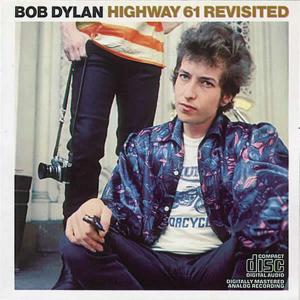
Highway 61 Revisited (1965)

1. Like a Rolling Stone
2. Tombstone Blues
3. It Takes A Lot to Laugh,
It Takes A Train to Cry
4. From a Buick 6
5. Ballad of a Thin Man
6. Queen Jane Approximately
7. Highway 61 Revisited
8. Just Like Tom Thumb's Blue
9. Desolation Row
If Bringing It All Back Home marked Dylan’s first foray into amplified music, Highway 61 Revisited was the full-throated declaration of its permanence. Gone were the concessions to his acoustic past. Here, the “folk singer” label—long clung to by the Village intelligentsia and Dylan’s earliest admirers—was unceremoniously jettisoned. In its place: a new Dylan, razor-tongued, electrically charged, and operating in a mode that owed as much to the raw energy of blues and rock ‘n’ roll as it did to the poetics of his earlier protest material.
From the opening snare crack of Like a Rolling Stone, there was no mistaking the transformation. Clocking in at over six minutes—a daring length for radio in 1965—the track reshaped the entire notion of the pop single. Lyrically elusive yet emotionally precise, the song’s sardonic portrait of alienation and collapse marked not only a creative high point for Dylan, but a redefinition of what could constitute popular music. It remains, with good reason, one of the most acclaimed recordings of the 20th century.
But to focus solely on Like a Rolling Stone is to overlook the cohesion and ferocity of the album as a whole. Tombstone Blues and From a Buick 6 extend Dylan’s embrace of surrealism and satire, marrying hallucinatory imagery to the gritty propulsion of blues-rock arrangements. It Takes a Lot to Laugh, It Takes a Train to Cry is perhaps the album’s most effortless fusion of Dylan’s early sensibility with his new direction—a slow-rolling lament that gestures toward tradition while subverting it entirely.
Throughout the album, Dylan eschews the didacticism of his earlier protest songs. The politics here are more oblique, more personal, yet no less potent. Ballad of a Thin Man offers a scathing attack on establishment incomprehension, its enigmatic chorus (“Something is happening here, but you don't know what it is...”) directed like a dagger at Dylan’s critics. Queen Jane Approximately introduces country inflections, and Just Like Tom Thumb’s Blues is a bleak travelogue through psychic and moral collapse.
The closer, Desolation Row, returns to acoustic guitar, but not to familiarity. It is a vast, eleven-minute epic—part nightmare, part sermon, part circus sideshow. Its cast of characters, drawn from literature, myth, and modern decay, jostle for space in a world collapsing under the weight of its own contradictions. For all its sprawl, it remains unnervingly focused, a final act of bardic defiance that confirms Dylan’s place not just as a songwriter, but as a seer.
Highway 61 Revisited is not merely a high point in Dylan’s career—it is one of the most decisive moments in the evolution of rock music itself. Unapologetically bold, brilliantly confrontational, and musically daring, it represented the full flowering of a vision that Dylan would continue to revise, resist, and reinvent. That he was met with boos and jeers from pockets of his former audience only confirmed that he was, as always, ahead of the curve.
Go back to the main page
Go To Next Review